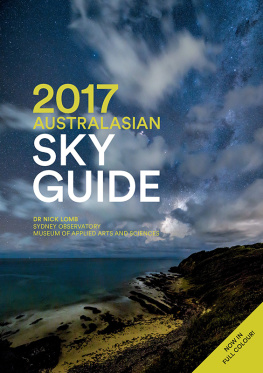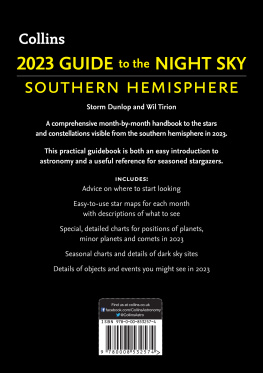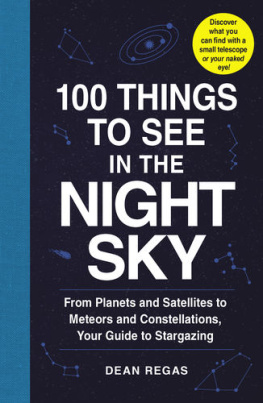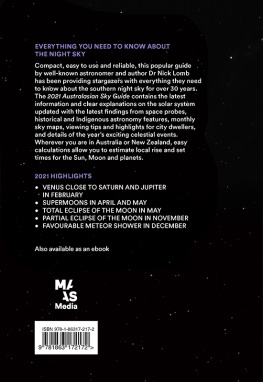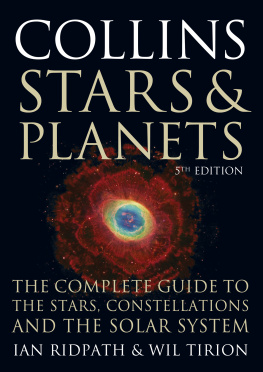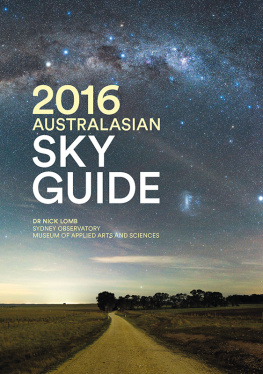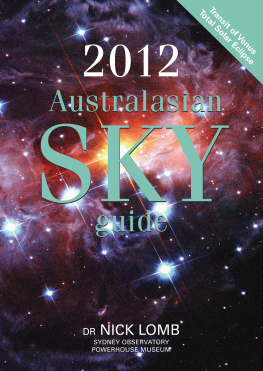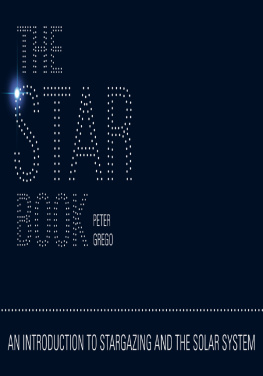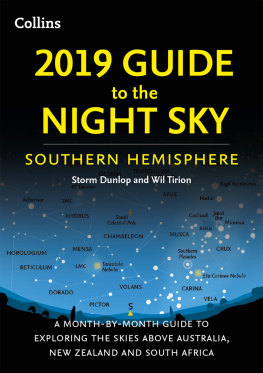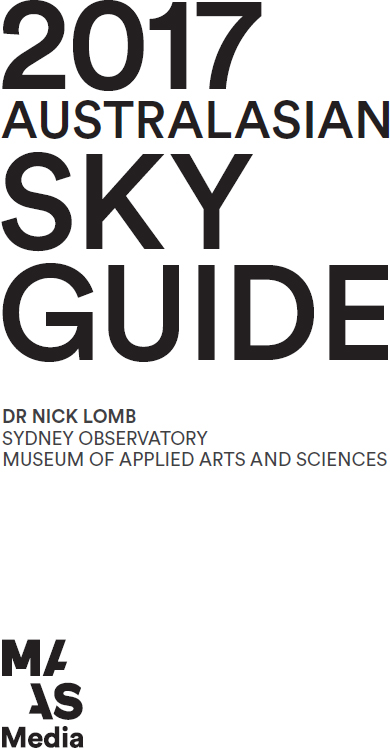
Published annually since 1991 by Museum of Applied Arts and Sciences Media (formerly Powerhouse Publishing) Museum of Applied Arts and Sciences 500 Harris Street, Ultimo NSW 2007 maas.museum/store
PUBLICATION MANAGER Judith Matheson
EDITOR Vanessa Pellatt
DESKTOP PUBLISHING Anne Slam
DIAGRAMS AND ILLUSTRATIONS Andy Chong/Picture This
COVER DESIGN i2i Design
PRINTING Ligare
ISBN 978 1 86317 169 4 (paperback)
ISBN 978 1 86317 170 0 (ebook)
ISSN 22011765
2016 Trustees of the Powerhouse Museum.
The Museum of Applied Arts and Sciences is an executive agency of the NSW Government.
This book is copyright. Apart from fair dealing for the purposes of study, research, criticism or review, or as otherwise permitted under the Copyright Act, no part of this publication may be reproduced by any process without written permission. Inquiries should be made to the publisher.
The author wishes to acknowledge the assistance and contributions made by staff at Sydney Observatory. The original monthly sky maps were prepared by Rod Somerville using the program Skymap.
All material is supplied in good faith and is believed to be correct. It is supplied on the condition that no warranty is given in relation thereto and no responsibility or liability for error or omission is, or will be, accepted.
At the time of publication, Daylight Saving Time ends in NSW, ACT, Victoria, South Australia, Tasmania and New Zealand at 3:00 am on Sunday 2 April 2017, when clocks should be turned back to 2:00 am. Daylight Saving Time begins again at 2:00 am on Sunday 24 September 2017 in New Zealand and at 2:00 am on Sunday 1 October 2017 in the relevant Australian states (see ). The information in this publication has been adjusted for summer time using the above times and dates.
The tide predictions for Sydney (Fort Denison) have been formatted by Museum of Applied Arts and Sciences Media from material supplied by the Bureau of Meteorology. The Bureau of Meteorology gives no warranty of any kind whether express, implied, statutory or otherwise in respect to the availability, accuracy, currency, completeness, quality or reliability of the information or that the information will be fit for any particular purpose or will not infringe any third party Intellectual Property rights. The Bureaus liability for any loss, damage, cost or expense resulting from use of, or reliance on, the information is entirely excluded.
About the cover imageNIGHT AT THE BEACHThis photograph by Judith Conning shows the southern sky and Milky Way from Seascapes near Taree, NSW. The Southern Cross is at top right.Saturn sits below the cloud near the centre. Mars illuminates the cloud from above. It received an Honorable mention in the Nightscapes category in the David Malin Awards 2016.
Photo courtesy Judith Conning
Back cover: Sydney Observatory
CONTENTS

HOW TO USE THIS BOOK
Most of the astronomical information provided in this book is suitable for the whole of Australia and New Zealand. The descriptions of celestial events each month, such as the positions and movements of the planets, apply anywhere in the two countries. For local times of lunar eclipses and phases of the Moon in different time zones, just add or subtract the time difference; eg for New Zealand add two hours and for Western Australia subtract two or three (depending on daylight saving in eastern Australia).
Rise and set times
The rise and set times for the Sun, Moon and planets have been calculated for Sydney, but with suitable adjustments they can provide approximate times elsewhere. If you are close to the 34 latitude of Sydney you can adjust the times very simply for your location: take the difference between Sydneys longitude of 151.2 East and the longitude of your location (you can find this on most maps), multiply by 4 and add the result in minutes. The tide tables apply to Sydney only.
Capital cities
The following corrections are based on longitude differences and allow for daylight saving. For Melbourne, Adelaide, Perth and Auckland the possible errors with these adjustments will only be a few minutes. The errors will be somewhat larger for the other cities.

HIGHLIGHTS FOR 2017
3 JANUARY Mars near the Moon. In the evening sky after dusk the red planet and the crescent Moon are close together (see ).
13 JANUARY Venus near Neptune. In the evening sky the bright planet Venus acts as a signpost to viewing the outermost planet Neptune through binoculars (see ).
2627 FEBRUARY Mars close to Uranus. The red planet makes it easy to find the seventh planet from the Sun through binoculars (see ).
6 MAY Eta Aquariid meteor shower. There is a good window of opportunity to see one of the years best meteor showers after the set of the gibbous Moon (see ).
25 JULY Mercury near the Moon. In the evening sky the elusive planet Mercury, the nearby bright star Regulus and a thin crescent Moon form a twisted smile in the sky (see ).
8 AUGUST Partial eclipse of the Moon. In the early morning a partial eclipse of the Moon is visible throughout Australia and New Zealand (see ).
18 SEPTEMBER Venus near Moon. Venus brightly shines close to the horizon with a very thin crescent Moon just above the planet (see ).
6 OCTOBER Venus approaches Mars. Low in the dawn sky, visible only through binoculars or a telescope, the red planet Mars appears very close to the bright planet Venus (see ).
14 NOVEMBER Venus close to Jupiter.
Very low in the dawn sky the two brightest planets, Venus and Jupiter, are only a moon-width apart (see ).
1415 DECEMBER Geminid meteor shower. This year a crescent Moon provides little interference with viewing the last major meteor shower of the year (see ).

On the morning of 14 November 2017 Venus and Jupiter are three times closer together than in this image, taken 2 September 2005. However, this years encounter between the two brightest planets can only be seen low down near the horizon and in the twilight. Photo Nick Lomb
THIS YEARS EVENTS
8 AUGUST Partial eclipse of the Moon.
A partial eclipse of the Moon is visible throughout Australia and New Zealand on the early morning of Tuesday 8 August. The eclipse lasts 1 hour 56 minutes from the time the Moon enters the dark shadow of the Earth, the umbra, until it leaves the shadow. At the maximum of the eclipse 25 per cent of the width of the Moon is immersed in the umbra.
Unlike an eclipse of the Sun, an eclipse of the Moon is completely safe to watch with the naked eye and without special filters. Although the eclipse should be a spectacular sight, the red colour associated with a total eclipse of the Moon is unlikely to be evident in the eclipsed portion of the Moon on this occasion. Photography is possible, preferably with a camera mounted on a tripod and a zoom lens.
Circumstances in different Australian and New Zealand cities are given in the table below. All times are local.
Next page
